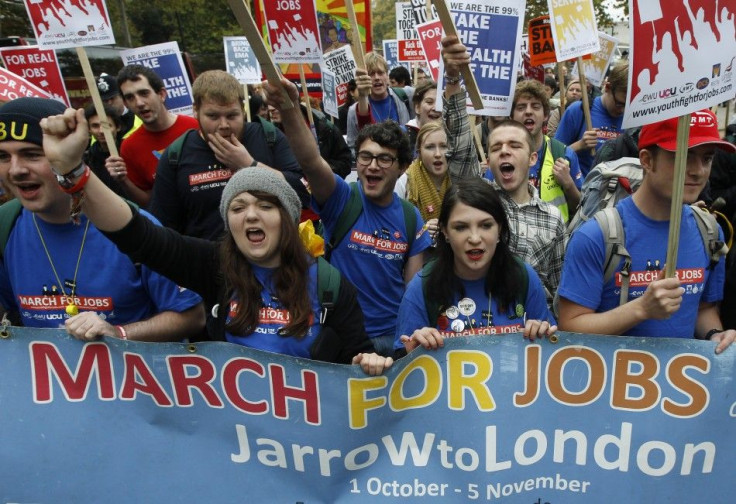Jarrow March Arrives in London Demanding Jobs; How Times Never Change

Demonstrators commemorating the legendary 1936 ‘Jarrow March’ by re-enacting the famous 200-mile trek from the northeastern town have arrived in Trafalgar Square in London after one month.
As in 1936, the current rally was a protest against mass unemployment in Great Britain. They were joined by other protesters who assembled at the Embankment overlooking the River Thames.
Jarrow MP Stephen Hepburn told the rally that a cancer existed in the City of London (the nation’s financial heart) and he praised protesters who have set up camp outside St Paul's Cathedral in imitation of the anti-capitalist demonstrations that have sprung up across the U.S.
We won't accept the crumbs on the table, Hepburn said.
Amidst a threat by unions to stage massive nationwide rallies to protest the coalition government’s austerity program (which include tax hikes, spending cuts and pension freezes), the Jarrow march has become extremely relevant to new generation of Britons.
Like their Jarrow forebears, the current marchers handed over a petition to 10 Downing Street to demand a government job creation scheme, an end to college tuitions and the re-instatement of cancelled youth service programs, among other measures.
The current march was organized by protest group Youth Fight for Jobs (YFJ).
YFJ spokeswoman Claire Laker Mansfield told BBC: Young people have shown that far from being lazy or scroungers, they want a future with decent jobs and education. The marchers have received huge support up and down the country. People have fed them, put them up and made it clear they back our demands.
She added: We think it is unfair that in the 21st Century, young people are facing long-term unemployment. There are almost a million young people out of work, and the jobs market is not getting any better.
But what exactly was the Jarrow March?
In October 1936, amidst extreme poverty and high unemployment across Great Britain, 200 jobless men from the town of Jarrow in the northeastern part of England, marched 280 miles to the capital London to protest their appalling living conditions and the general economic misery afflicting Britain.
The march became popularly known as the ”Jarrow March” or the “Jarrow Crusade” – a landmark in British labor history.
Jarrow, in South Tyneside, was formerly a shipbuilding and steel manufacturing center which had collapsed into hard times due to the global economic depression of the 1930s.
The previous year, the famous Palmers Shipbuilding and Iron shipyard in Jarrow, the town’s dominant employer for decades, was shut down, throwing hundreds out of work.
The marchers were accompanied by their local MP Ellen Wilkinson who petitioned Parliament in Westminster to relieve their woes and build a new steel facility.
At that time, unemployment benefits lasted only 26 weeks – and extensions were hard to get and usually sub-standard.
Like some of the OWS protesters, the men of Jarrow asserted they were hard-working, law-abiding people who were victimized by economic forces beyond their control – indeed, unemployment in Jarrow at the time was believed to be an astonishing 70 percent,
One marcher described the town as “a filthy, dirty, falling down, consumptive area.”
MP Wilkinson, who was one of the first women ever elected to Parliament, wrote of Jarrow at the time: “There was no work. No one had a job except a few railwaymen, officials, the workers in the co-operative stores, and a few workmen who went out of the town... the plain fact [is] that if people have to live and bear and bring up their children in bad houses on too little food, their resistance to disease is lowered and they die before they should.”
However, the Jarrow March was hardly unusual for its time – scores of similar protests and marches were occurring in Britain. However, the Jarrow men were careful to distinguish their demonstration from others which were linked to Socialist and Communist parties, which espoused revolution.
While Wilkinson was herself a Communist at one time, no Communists were allowed in the march.
Indeed, the Jarrow march even attracted some Conservative politicians to its side, as well as financial contributions for their travelling and accommodation costs.
The march (which, excluding Wilkinson, consisted of strong, healthy, able-bodied men) took 25 days to reach London.
However, despite entreaties by Wilkinson, Prime Minister Stanley Baldwin, a Conservative, refused to see the Jarrow men.
In the long term, conditions in Jarrow gradually improved, An engineering works and ship-breaking facility was built in 1938, followed by a steel works the following year.
Wilkinson died in 1947, reportedly of a suicide.
The last known Jarrow marcher, 93-year-old Cornelius Whalen, passed away in 2003.
Meanwhile, about 2.51 people in the UK are now unemployed, including 973,000 youths, translating into a national jobless rate of 7.9 percent, according to the Office for National Statistics (ONS).
© Copyright IBTimes 2024. All rights reserved.





















